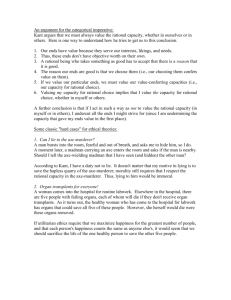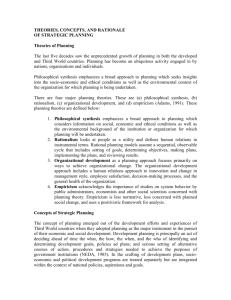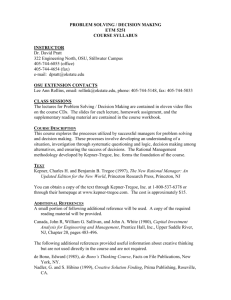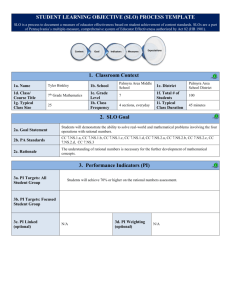The “Gold Standard”: Rational Actor Model
advertisement
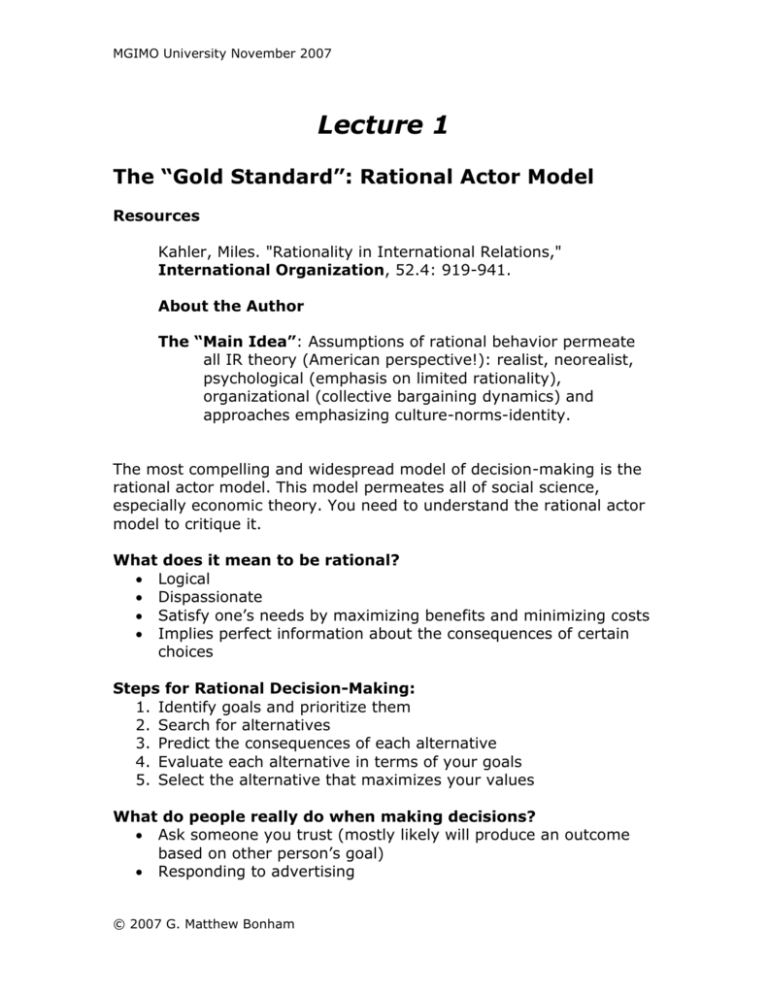
MGIMO University November 2007 Lecture 1 The “Gold Standard”: Rational Actor Model Resources Kahler, Miles. "Rationality in International Relations," International Organization, 52.4: 919-941. About the Author The “Main Idea”: Assumptions of rational behavior permeate all IR theory (American perspective!): realist, neorealist, psychological (emphasis on limited rationality), organizational (collective bargaining dynamics) and approaches emphasizing culture-norms-identity. The most compelling and widespread model of decision-making is the rational actor model. This model permeates all of social science, especially economic theory. You need to understand the rational actor model to critique it. What does it mean to be rational? Logical Dispassionate Satisfy one’s needs by maximizing benefits and minimizing costs Implies perfect information about the consequences of certain choices Steps for Rational Decision-Making: 1. Identify goals and prioritize them 2. Search for alternatives 3. Predict the consequences of each alternative 4. Evaluate each alternative in terms of your goals 5. Select the alternative that maximizes your values What do people really do when making decisions? Ask someone you trust (mostly likely will produce an outcome based on other person’s goal) Responding to advertising © 2007 G. Matthew Bonham MGIMO University November 2007 Ask your spouse/partner; compromise (usually as part of the goal-forming process) Rational only describes the decision-making process, not the values or outcome. Lecture Notes: Rational Calculations for Hostage Crisis (MSPowerPoint 126KB) Normal Utility Maximizing Function: E(U) = sum of P V E(U)1 is the expected utility of alternative 1 N is the number of possible outcomes Vi is the value of the ith outcome affected by the alternative Pi is the probability that the alternative will result in the outcome Sum the values of the expected value of all the outcomes times the probability of each outcome. Reagan’s Hostage Crisis 1. Sell Arms to Iran 2. Rescue Mission 3. Third Party 4. Do Nothing Outcomes from Alternative 1: V x P = U Hostages are Released: + 80 x .6 = +48 Improve Relations with Iran: + 50 x .9 = +45 Help Freedom Fighters (Contras): + 20 x .3 = +6 Harm Terrorism Policy (if discovered): -100 x .2 = -20 TOTAL UTILITY of Alternative 1 = 79 (48+45+6-20) Going through the exercise in practice reveals the difficulty, both in quantifying goals and priorities and in estimating probability. The Reagan Administration grossly overestimated their ability to keep this a secret, and when it went public, it did a great deal of harm to the Administration and to US terrorism policy. Why is it difficult? Different people have different priorities, goals, calculations of probabilities Decisions are made in a bureaucratic environment where many actors tend to prefer the status quo Consequences in foreign policy are difficult to predict © 2007 G. Matthew Bonham MGIMO University November 2007 Time is short and events can overtake reality (what if key actors are assassinated?) Alternatives: Play Politics Satisficing - settling for an alternative that may not maximize your utility, but it satisfies key constituents. I know this isn’t going to work, but I have to do something and this is the least objectionable alternative for most people. Ex) blockade Cuba The President makes a decision – “the buck stops here” Assemble a panel of like-minded advisors, who provide political cover if something goes wrong: “all my advisors told me this would work.” Practitioner’s Hour Case Study – President Bush’s Decision to Invade Iraq “Because September 11th made the security of the American people the priority…a sacred duty for the president. It is the most necessary duty for the president, because if the president doesn’t take on that duty, who else is going to?” Saddam was a “madman.” “He had weapons of mass destruction in the past. He has created incredible instability in the neighborhood” (Bush quoted in Woodward, Plan of Attack, 2004, p. 27) Was the Decision Rational? The military didn’t want to go in. Secretary of State Powell kept saying, “This is lunacy” (Woodward, 2004, p. 22). They preferred other approaches. There was little weighing of the alternatives and consequences “Two months into the job, Rumsfeld drafted a three-page memo called ‘Guidelines When Considering Committing U.S. Forces’….It was a series of questions to be addressed: ‘Is a proposed action truly necessary?’ ‘Is the proposed action achievable?’ ‘Is it worth it?’’ (Woodward, Plan of Attack, 2004) Rational Decision-Making Model for the Iraq War © 2007 G. Matthew Bonham MGIMO University November 2007 Three options: military force, vigilant containment; (Mearsheimer and Walt, “An Unnecessary War,” Foreign Policy, No. 134, [Jan. - Feb., 2003], 50-59); and do nothing What are the likely outcomes of each? “Is it worth it?” Alternative 1 – Military Force Outcomes Removal of Saddam Destruction of WMD Democracy in the region Military casualties (US and allies) Civilian casualties High monetary cost Lengthy occupation (quagmire) Complicated relations with other countries Alternative 2 – Vigilant Containment (phased strategy of pressuring Saddam, including diplomatic and economic sanctions, as well as efforts to strengthen the opposition within Iraq) Outcomes Saddam remains in power Risk of continued development of WMD Risk of terrorism International cooperation Sanctions are undermined by smuggling and non-compliance Other: Alternative 3 – Do Nothing Outcomes Utilities of each alternative Choice © 2007 G. Matthew Bonham MGIMO University November 2007 © 2007 G. Matthew Bonham

